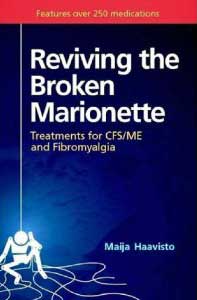 Another treatment book I thought…….Dr. Teitlebaum’s books had pretty comprehensively covered the waterfront for me on that end. What more could a patient authored book offer? It turns out – a lot.
Another treatment book I thought…….Dr. Teitlebaum’s books had pretty comprehensively covered the waterfront for me on that end. What more could a patient authored book offer? It turns out – a lot.
Maija Haavisto is a Finnish writer with CFS who’s health was declining rapidly when she found a drug, low-dose Naltrexone. (LDN), that stopped the progression of her illness and improved many of her symptoms. (She used a draft of the book to convince her physician to try it.)
“Reviving the Broken Marionette: Treatments for CFS/ME and Fibromyalgia” focuses on the pharmaceutical drugs used to treat CFS. First she explains how each class of drug works and why it might be applicable. Then she covers how each drug works, study or physician information on each, it’s possible side effects, cost and availability in different countries.
She clearly has a lot of contacts as she uncovers treatment after treatment option I had never heard of. A particularly important and now pretty much neglected source is the work of Dr. Jay Goldstein. Her chapter on Nootropics – “smart drugs” that skirt the boundary between stimulants and mood altering drugs (and are usually quite well tolerated) was eye-opening. Did you know Dr. Goldstein used ergoloid , a strong anti-oxidant that improves oxygenation to the brain and is used to treat migraine and senile dementia to good effect in some of this patients. Or that vinpocetine, which has anticonvulsant properties and improves brain microcirculation might be able to increase physical endurance in CFS.
Besides covering all the antimicrobrials, antimicrobrials, antivirals, beta blockers, corticosteroids, cholinesterase inhibitors, etc., etc. used in CFS she has an impressive section on experimental therapies. Did you know that tadalafil (Cialis), which is related to Viagra, improved shortness of breath and improved exercise tolerance in one study? Or that some people with ME/CFS have noted improvement from oversensitivity after using the motion sickness drug scopolamine? Or that theophylline might be able to help neutrally mediated hypotension (low blood pressure upon standing) in ME/CFS?
Sometimes Maija reaches beyond study and online material and covers treatments that possibly could be helpful. There’s ibudilast (ketas), an anti-inflammmatory, anti-allergic vasodilator used in asthma and multiple sclerosis . Could it have neuroprotective effects in ME/CFS as well? How about monteleukast (singuliar) – an anti-inflammatory helpful in interstitial cytisus – might it have a role to play for some?
Did I mention she also covers studies on ME/CFS’s cousins such as irritable bowel syndrome, interstitial cytisus? The book has a good index that can be helpful in tracking down treatments for symptoms and everything is fully referenced with over 1,000 citations. This 350 page, handsomely designed book is clearly a work of love and Maija’s commitment to uncovering the last pertinent fact on every possible pharmaceutical treatment is impressive indeed. (Her web site contains regular updates on the drug findings for ME/CFS and Fibromyalgia – the only site I know of that does that).
- Video of Maija on Reviving the Broken Marionette
Maiha Haavisto on Reviving the Broken Marionette: A CFS/FM treatment book
Except for intramuscularly injected supplements (B-12, magnesium, Myer’s Cocktail) there’s no information on supplements but this book is a gold mine for information on the over 250 pharmaceutical treatments used in ME/CFS. At the very least it should be on the bookshelf of every CFS physician and many people with ME/CFS. Not every patient wants to dig through or needs information on all the anti-convulsant drugs, for instance, used in ME/CFS but if you want to learn about the wide variety of pharmaceutical treatments available for CFS -and the options your physician might have missed – this is the book. Five stars.
* Buy the book on the Broken Marionette website or on Amazon.com
* Check out a review by the Patient Advocate
* Maija’s personal website
Video of Maija on her LDN treatment
